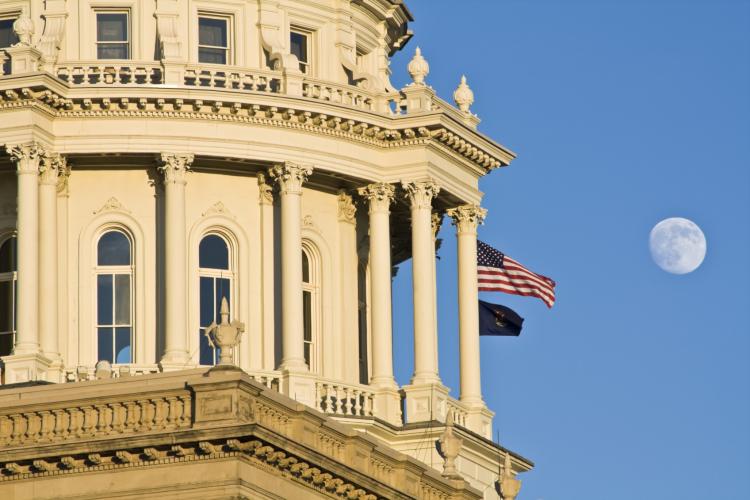
After many months of legislative negotiations, Governor Whitmer signed SB271, SB273 and SB502 into law on November 28. Collectively these three bills transform Michigan’s energy policy by establishing a 100% clean energy standard by 2040, increasing the state’s energy waste reduction (EWR) standard and expanding the purview of the Michigan Public Service Commission (MPSC).
See below for more details of these three new laws:
SB 271 (Sen. Geiss): Sets renewable energy and clean energy goals
- Increases renewable portfolio standard
- Mandates electric investor-owned utilities generate or acquire renewable energy (through resources or credits) of at least 15% through 2027, 50% by 2030 and 60% by 2035
- Establishes clean energy requirements
- Requires electric providers achieve a clean energy portfolio of 80% by 2035 and 100% by 2040
- Defines which resources count as renewable and which are considered clean
- Renewable resources: Includes solar, wind, hydropower (with defined restrictions), geothermal and biomass (including some defined landfill gas and biodigesters)
- Does not include petroleum, nuclear, natural gas, industrial waste, post-use polymers, tire-derived fuel, plastic or coal
- Clean resources: Includes all renewable resources along with nuclear and natural gas generation where more than 90% of its carbon emissions are captured and stored
- Allows electric utilities that reach over 2% in annual EWR savings to utilize those savings as renewable portfolio credits and achieve up to 10% of their renewable energy standard requirements through EWR
- Renewable resources: Includes solar, wind, hydropower (with defined restrictions), geothermal and biomass (including some defined landfill gas and biodigesters)
SB 273 (Sen. Singh): Modifies EWR program
- Increases EWR standard
- Raises the EWR standard for electric utilities to 1.5% in annual savings, with an incentive structure to encourage utilities to reach 2.17%
- Raises the EWR standard for gas utilities to .875% in annual savings, with an incentive structure to encourage utilities to reach 1.25%
- Encourages (with an additional incentive) gas utilities to direct at least 67% of their EWR program spend on measures that reduce heating load (air sealing, insulation, efficient windows or doors, ventilation systems, heating distribution systems and heating system controls)
- Adds municipal and cooperative utilities back into the EWR standard
- Allows for efficient electrification within the EWR program
- Defines efficient electrification: measure must reduce total energy consumption at the premises, reduce greenhouse gas emissions over the life of the measure and, for residential and commercial customers interconnected at secondary voltage, provide annual average energy cost savings
- Allows municipal and cooperative electric utilities and all gas utilities to claim savings from efficient electrification measures toward their EWR goals
- Increases low-income EWR requirements
- Mandates electric utilities direct at least 25% of their EWR portfolio spending on low-income EWR programs; gas utilities must spend 35%
- Requires utilities reduce barriers to ensure more low-income customers can participate in EWR programs
- Adds requirements that large utilities (with more than 50,000 customers) must invest and develop a diverse EWR workforce, including an emphasis on hiring from low-income, environmental justice and energy transition-impacted communities
- Modifies timelines for future EWR filings
SB 502 (Sen. Shink): Expands the charge of the MPSC
- Modifies utility requirements in integrated resource plans (IRPs)
- Requires utilities to assess the potential of electrification of transportation, buildings and industries; include reasonably anticipated environmental justice impacts; include affordability impacts; and project long-term forecast of greenhouse gas emissions and pollutants from power generated or purchased by the electric utility
- Expands the criteria that the MPSC can consider in IRPs
- Allows the MPSC to consider affordability, environmental impacts and health impacts in IRP decisions
- Mandates the MPSC consider a Department of Environment, Great Lakes, and Energy (EGLE) advisory opinion on how the proposed IRP would affect emissions, make progress toward the state’s goal of carbon neutrality by 2050, affect human health and impact environmental justice communities
- Increases funding for the utility consumer representation board
- Mandates the MPSC study how to better expand opportunities for public engagement in its decision-making processes
These bills demanded months of negotiations, and, as with most legislation, not everyone is completely satisfied with the resulting language, but passing any comprehensive climate legislation is difficult. With the enactment of its clean energy target, Michigan will join Illinois and Minnesota as the only Midwestern states that have passed legislative mandates to decarbonize electricity generation by mid-century. Importantly, in passing SB273, Michigan legislators recognized the need to include energy efficiency as an essential tool to meeting the state’s clean energy target.
With two Democratic Representatives winning mayoral races this month, Michigan Democrats have lost their trifecta for now. Without a majority, the House will likely not vote on much leading to a quiet start of the 2024 session. Fortunately, the passage of these three bills builds upon a successful session where Michigan legislators passed dozens of bills, including those that expand the state’s commercial Property Assessed Clean Energy program, repeal the sunset of the Michigan Energy Assistance Program, modify renewable energy siting regulations and ensure energy workers and communities experience a just transition.